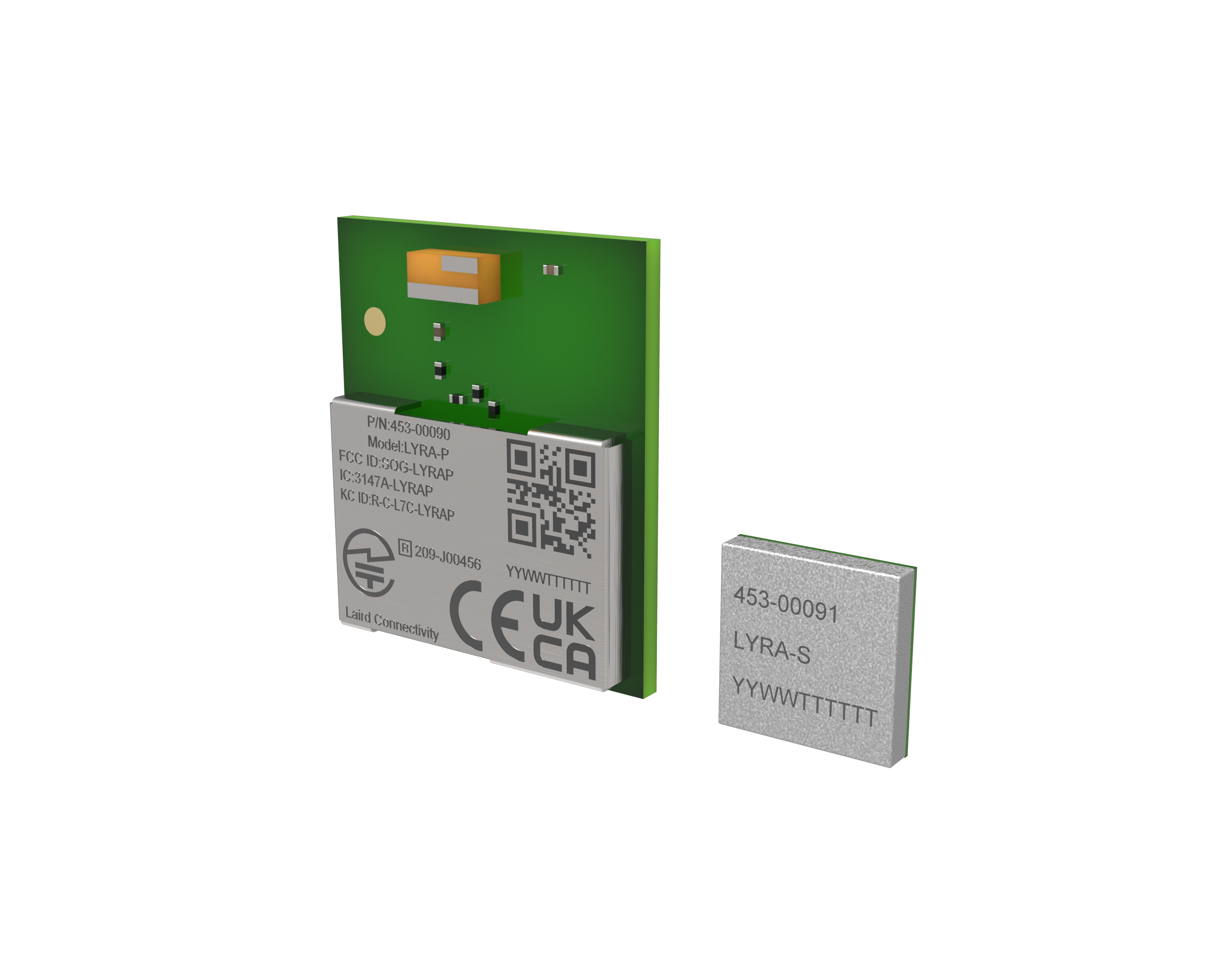
Lyra Series: Frequently Asked Questions
A short list of the most commonly-asked questions about getting started with our Lyra Series Bluetooth 5.3 modules.
Published on February 2, 2023

Common Questions and Answers – Introduction
Our Lyra Series Bluetooth 5.3 modules, based on the Silicon
Labs EFR32BG22 SoC, is our latest addition to our range of BLE modules. It
brings all the benefits of Silicon Labs hardware, software, and tools offerings
with Ezurio's (formerly Laird Connectivity) added value application software, services,
certification, and support capabilities. This seamless partnership provides
customers with multiple software development options suited to their resources
and skillsets in Bluetooth LE-enabled product development.
Partially as a result of the fact that this module is an
extension of Silicon Labs’ existing product line, customers often have several
questions about differences between the Lyra Series and the previous BGX220
offerings. In particular, customers often have questions about how the modules
and development kits are configured on arrival, as well as what’s changed
between the Lyra and the BGX220.
In this post, we want to address a few helpful questions and
answers that we frequently see with customers that can be helpful in terms of
getting started with the modules, developing the modules, and accessing support
and documentation materials that are useful for OEMs.
#1: How are the modules programmed out of the box?
Customers frequently are under the impression that the Lyra
modules are programmed out of the box with Wireless Xpress (BGX) software. This
is not the case: as part of our Lyra Series offering, we offer three distinct
routes to firmware development: Our fully-featured AT Command Set, Wireless
Xpress (frozen at the current release), and full C Code development with
Silicon Labs’ SDK and toolchain.
For this reason, all manufactured Lyra modules ship
pre-programmed with our own Ezurio bootloader type / configuration and
a factory application. The bootloader enables firmware programming via Serial
DFU (UART) on modules reset by triggering the BOOT pin and the factory application
can be used to upload firmware over-the-air (OTA) via BLE for certain software options.
Please keep in mind that in order to run Wireless Xpress on Lyra access to
either UART and/or SWD interface is required. OTA cannot be used for the
initial Wireless Xpress software programming. For full details on the firmware
options available for the Lyra series, where to find firmware, and how to flash
to the modules, see our user guide: “Firmware
Options and Upgrade Methods – Lyra Series.”
For more questions and answers on this subject, please see
the following FAQs:
- Is it possible to get pre-programmed Lyra parts from you?
- What is the difference between the Ezurio and legacy Bluetooth Xpress (BGX) bootloader you provide for Lyra?
- What are the factory states for your Lyra DVKs and modules?
- Can I run with Lyra multiple firmware options simultaneously?
We also highly recommend reviewing our latest BGX13
/ BGX220 to Lyra Series – Bluetooth Xpress Migration Guide carefully.
#2: Where can I find Certifications and Test Reports for the Lyra Series?
Our Lyra Series test reports and certifications, which cover
approvals for USA (FCC), Canada (ISED), United Kingdom (UKCA), Europe (CE),
Japan (MIC/TELEC), and Korea (KC), are based on the original approvals secured
by Silicon Labs for the BGX220 series modules. They are available by request
for customers.
To request certifications and test reports for the Lyra
Series, contact us on the web via our contact us page.
For the Bluetooth SIG product registration and listing it is
required to complete the Bluetooth
SIG Declaration Process (Qualification Process with no required Testing) as
described in our Lyra datasheets under section 13: Bluetooth SIG Qualification:
#3: How do I debug and program the Lyra Series Modules?
The Silicon Labs BGX13 and BGX220 modules did not previously
support a Serial Wire Debug (SWD) interface. We support replacing (or
recovering) the Lyra bootloader through SWD as this is not possible via UART or
OTA. Additionally, SWD can be used for all advanced developer tasks as such
debugging or programming the module. We encourage customers to implement the
SWD interface for all new Lyra-based designs whenever possible.
The Lyra P and Lyra S development kit guides cover the
functionality and pinout of the onboard debugging interface, as well as how to
connect and use the debugging interface. For more information, see the
development kit guide for your Lyra model:
Please note that all Lyra DVKs ship completely empty and
erased with no bootloader and no application preloaded. Before getting started,
make sure to first program both a bootloader and application image on your Lyra
DVK. You can find all available images on our Lyra Firmware Release GitHub page
under https://github.com/LairdCP/Lyra_Firmware/releases.
#4: Where can I find community support for the Lyra Series?
Ezurio has an international sales and support
organization that provides Tier-2 FAE and engineering support for our
customers. However, the Lyra Series also has a public support channel available
via the Silicon Labs website, which
you can join here.
The Bluetooth LE Lyra board is a great place to ask and
answer questions, support others, and earn point for participating in the
community. You can search by existing questions, articles, projects, and
topics, as well as ask your own questions.
More on the Lyra Series
For more information on the Lyra Series modules, as well as
access to product specifications, documentation, software, and more, visit the
Lyra Series page on our website:
 Laird Connectivity is now Ezurio
Laird Connectivity is now Ezurio